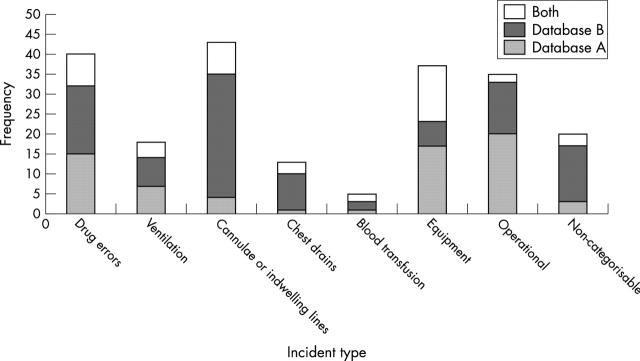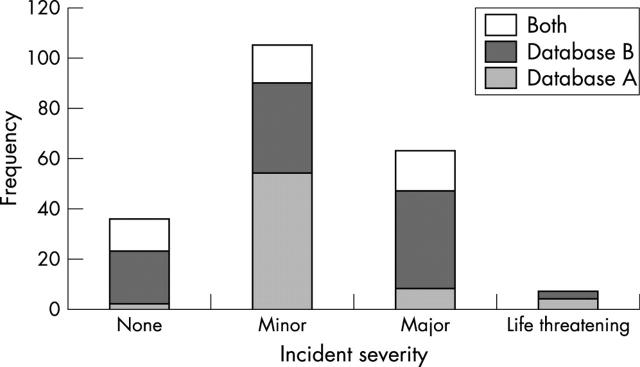Abstract
Aims: To evaluate the pitfalls of incident reporting in a complex medical environment.
Methods: Retrospective review of 211 incident reports in a paediatric cardiac intensive care unit (CICU). Two adverse event reporting databases were compared: database A (DA), the hospital's official reporting system, is non-anonymous and reports are predominantly made by nurses; database B (DB) is anonymous and reports are submitted by a CICU consultant who collects data from daily ward rounds. Both databases classify adverse events into incident type (drug errors, ventilation, cannulae/indwelling lines, chest drains, blood transfusion, equipment, operational) and severity (0 = no, 1 = minor, 2 = major, 3 = life threatening consequences).
Results: Between 1 April 1998 and 31 July 2001 there were 211 adverse events involving 178 patients (11.87%), among 1500 patients admitted to CICU. A total of 112 incidents were reported in DA, 143 in DB, and 44 in both. In isolation, both databases gave an unrepresentative picture of the true frequency and severity of adverse events. Under-reporting was especially notable for less severe events (grade 0, or near misses)
Conclusion: Incident reporting in the medical field is highly variable, and is heavily influenced by profession of the reporters as well as anonymity. When adverse event reporting is based predominantly on the observations of a single professional group, the data are grossly inaccurate.
Full Text
The Full Text of this article is available as a PDF (92.7 KB).
Figure 1.
Frequency of incident types per database.
Figure 2.
Severity of incidents per database.
Selected References
These references are in PubMed. This may not be the complete list of references from this article.
- Barach P., Small S. D. Reporting and preventing medical mishaps: lessons from non-medical near miss reporting systems. BMJ. 2000 Mar 18;320(7237):759–763. doi: 10.1136/bmj.320.7237.759. [DOI] [PMC free article] [PubMed] [Google Scholar]
- Bates D. W., Cullen D. J., Laird N., Petersen L. A., Small S. D., Servi D., Laffel G., Sweitzer B. J., Shea B. F., Hallisey R. Incidence of adverse drug events and potential adverse drug events. Implications for prevention. ADE Prevention Study Group. JAMA. 1995 Jul 5;274(1):29–34. [PubMed] [Google Scholar]
- Brennan T. A., Leape L. L., Laird N. M., Hebert L., Localio A. R., Lawthers A. G., Newhouse J. P., Weiler P. C., Hiatt H. H. Incidence of adverse events and negligence in hospitalized patients. Results of the Harvard Medical Practice Study I. N Engl J Med. 1991 Feb 7;324(6):370–376. doi: 10.1056/NEJM199102073240604. [DOI] [PubMed] [Google Scholar]
- Cohen M. R. Why error reporting systems should be voluntary. BMJ. 2000 Mar 18;320(7237):728–729. doi: 10.1136/bmj.320.7237.728. [DOI] [PMC free article] [PubMed] [Google Scholar]
- Donchin Y., Gopher D., Olin M., Badihi Y., Biesky M., Sprung C. L., Pizov R., Cotev S. A look into the nature and causes of human errors in the intensive care unit. Crit Care Med. 1995 Feb;23(2):294–300. doi: 10.1097/00003246-199502000-00015. [DOI] [PubMed] [Google Scholar]
- Gawande A. A., Thomas E. J., Zinner M. J., Brennan T. A. The incidence and nature of surgical adverse events in Colorado and Utah in 1992. Surgery. 1999 Jul;126(1):66–75. doi: 10.1067/msy.1999.98664. [DOI] [PubMed] [Google Scholar]
- Helmreich R. L. On error management: lessons from aviation. BMJ. 2000 Mar 18;320(7237):781–785. doi: 10.1136/bmj.320.7237.781. [DOI] [PMC free article] [PubMed] [Google Scholar]
- Lawton R., Parker D. Barriers to incident reporting in a healthcare system. Qual Saf Health Care. 2002 Mar;11(1):15–18. doi: 10.1136/qhc.11.1.15. [DOI] [PMC free article] [PubMed] [Google Scholar]
- Lesar T. S., Lomaestro B. M., Pohl H. Medication-prescribing errors in a teaching hospital. A 9-year experience. Arch Intern Med. 1997 Jul 28;157(14):1569–1576. [PubMed] [Google Scholar]
- Pietro D. A., Shyavitz L. J., Smith R. A., Auerbach B. S. Detecting and reporting medical errors: why the dilemma? BMJ. 2000 Mar 18;320(7237):794–796. doi: 10.1136/bmj.320.7237.794. [DOI] [PMC free article] [PubMed] [Google Scholar]
- Reason J. Human error: models and management. BMJ. 2000 Mar 18;320(7237):768–770. doi: 10.1136/bmj.320.7237.768. [DOI] [PMC free article] [PubMed] [Google Scholar]
- Ross L. M., Wallace J., Paton J. Y. Medication errors in a paediatric teaching hospital in the UK: five years operational experience. Arch Dis Child. 2000 Dec;83(6):492–497. doi: 10.1136/adc.83.6.492. [DOI] [PMC free article] [PubMed] [Google Scholar]
- Vincent C., Neale G., Woloshynowych M. Adverse events in British hospitals: preliminary retrospective record review. BMJ. 2001 Mar 3;322(7285):517–519. doi: 10.1136/bmj.322.7285.517. [DOI] [PMC free article] [PubMed] [Google Scholar]
- Vincent C., Stanhope N., Crowley-Murphy M. Reasons for not reporting adverse incidents: an empirical study. J Eval Clin Pract. 1999 Feb;5(1):13–21. doi: 10.1046/j.1365-2753.1999.00147.x. [DOI] [PubMed] [Google Scholar]
- Weingart S. N., Wilson R. M., Gibberd R. W., Harrison B. Epidemiology of medical error. BMJ. 2000 Mar 18;320(7237):774–777. doi: 10.1136/bmj.320.7237.774. [DOI] [PMC free article] [PubMed] [Google Scholar]
- Wilson R. M., Runciman W. B., Gibberd R. W., Harrison B. T., Newby L., Hamilton J. D. The Quality in Australian Health Care Study. Med J Aust. 1995 Nov 6;163(9):458–471. doi: 10.5694/j.1326-5377.1995.tb124691.x. [DOI] [PubMed] [Google Scholar]
- de Leval M. R., Carthey J., Wright D. J., Farewell V. T., Reason J. T. Human factors and cardiac surgery: a multicenter study. J Thorac Cardiovasc Surg. 2000 Apr;119(4 Pt 1):661–672. doi: 10.1016/S0022-5223(00)70006-7. [DOI] [PubMed] [Google Scholar]




